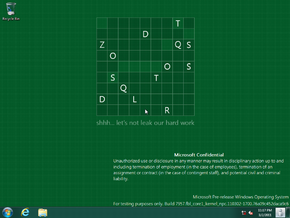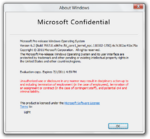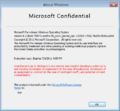Windows 8 build 7957 (fbl_core1_kernel_npc)
| Build of Windows 8 | |
 | |
| OS family | Windows NT |
|---|---|
| Version number | 6.2 |
| Build number | 7957 |
| Build revision | 0 |
| Architecture | ARM32 (ARMv7); x86 |
| Build lab | fbl_core1_kernel_npc |
| Compiled on | 2011-03-02 |
| Expiration date | |
| Timebomb | 2011-07-01 (+121 days) |
| SKUs | |
| Starter (N) Home Basic (N) Home Premium (N) Professional (N) Enterprise (N) Ultimate (N) | |
| About dialog | |
Windows 8 build 7957 (fbl_core1_kernel_npc) is a build of Windows 8. The original partner drop for both the retail and debug client releases of this build's unstaged ARMv7 installation media and Preinstallation Environment, including software development kits and raw symbol sets for Nvidia were uploaded on 11 September 2024 along with build 7898. Prior to its leak, a screenshot of this build was shared on the BetaWiki Discord server on 23 September 2021. The x86 free and checked compiles of this build was shared on 3 November 2024, along with build 7960's Windows Preinstallation Environment in the x86 architecture. The Qualcomm drop was later uploaded on 5 December 2024.
This build is also referenced in an installation guide for an Atmel touch screen driver package found within the 2022 Nvidia source code leak, which stated that the package is not compatible with this build. Build 7969 is also referenced in the same document.
It is notable for being one of the few Windows builds to be made available in the form of unstaged installation media[a]; all client editions available in the Windows 8 source tree at the time of compilation (albeit labeled as Longhorn, a holdover that was never corrected internally) are available for the user to pick from and install during setup, in turn building a complete Windows image from scratch from a set of components through the use of the Windows Component-Based Servicing (CBS) stack.
Editions and keys[edit | edit source]
The following SKUs are installable in this build:
| Edition / SKU Name | Key |
|---|---|
| Starter[b] | 7Q28W-FT9PC-CMMYT-WHMY2-89M6G |
| Starter N[b][a] | D4C3G-38HGY-HGQCV-QCWR8-97FFR |
| Home Basic | YGFVB-QTFXQ-3H233-PTWTJ-YRYRV |
| Home Basic N[a] | MD83G-H98CG-DXPYQ-Q8GCR-HM8X2 |
| Home Premium | RHPQ2-RMFJH-74XYM-BH4JX-XM76F |
| Home Premium N[a] | D3PVQ-V7M4J-9Q9K3-GG4K3-F99JM |
| Professional | HYF8J-CVRMY-CM74G-RPHKF-PW487 |
| Professional N[a] | BKFRB-RTCT3-9HW44-FX3X8-M48M6 |
| Enterprise[c] | H7X92-3VPBB-Q799D-Y6JJ3-86WC6 |
| Enterprise N[a] | BQ4TH-BWRRY-424Y9-7PQX2-B4WBD |
| Ultimate | D4F6K-QK3RD-TMVMJ-BBMRX-3MBMV |
| Ultimate N[a] | HTJK6-DXX8T-TVCR6-KDG67-97J8Q |
readme.txt[edit | edit source]
Usage instructions for Amtel 1386 Driver Requirements: Windows builds 7969 and higher (will NOT work on 7957) 1. Copy your c:\windows\system32\drivers\mshidkmdf.sys to the same directory as the driver/inf. 2. Modify the INF and replace all instances of TOUCH_ID with your Hardware ID. For example, if your Hardware ID for touch is ACPI\VENDOR_TCH, replace all instances of TOUCH_ID with VENDOR_TCH 3. Ensure that GPIO and I2C drivers are loaded before installing the driver. 4. Work with Atmel and Microsoft to adjust the calibration values in the INF to match your hardware.
Installation[edit | edit source]
Bugs and quirks[edit | edit source]
- In the ARM32 compile, Chess Titans and Mahjong Titans are listed as "Unspecified" in the Game Explorer.
Private builds of core components[edit | edit source]
The NVIDIA drop of the ARM32 compile contains privately built ntoskrnl.exe and kdusbtga.dll files of the free and checked flavor, complete with private symbols, in the cardhu directory of the drop, likely an attempt to support early cardhu-based development kits. The free/retail files have a buildtag of 6.2.7957.0 (fbl_core1_kernel_npc(adamg).110118-0015), the checked/debug files have a buildtag of 6.2.7957.0 (fbl_core1_kernel_npc(adamg).101217-1230).
Gallery[edit | edit source]
ARM32 variant[edit | edit source]
Interface[edit | edit source]
[edit | edit source]
Notes[edit | edit source]
- ↑ Jump up to: 1.0 1.1 1.2 1.3 1.4 1.5 1.6 Only available for the ARM32 variant.
- ↑ Jump up to: 2.0 2.1 The Starter edition (and its N counterparts), last included in Windows 7, had since been internally repurposed during Windows 8 development to act as a base for new and existing Windows client SKUs. The Web Server edition would also be identically repurposed during development of its server counterpart for both Desktop Experience and Core editions, although Standard Server would later take its place as the base for Server Core editions during the late development phases of Windows Server 2016, specifically during Redstone 1 development.
- ↑ Only available for the ARM32 variant or via manually staging it on the x86 retail or debug image.
- ↑ Jump up to: 4.0 4.1 If utilizing the quad-core variant of the Tegra 2 WoA fork, the machine configuration in the batch script must be modified to address 2 GB of RAM, and the patched
2gEFI firmware capsules must also be used to start up the virtual machine. Themulti2gcombination can be used to immediately boot into builds 8020 through 8061; if this combination is not being used, then necessary registry modifications against theSYSTEMhive to load Tegra 2 HAL extension IDsVEN_ra2.&DEV_0002(HalExtTegra2.dll) andVEN_ra2.&DEV_0003(HalExtTegra2Dma.dll; in later builds,HalExtTegraDma.dll) are required.




